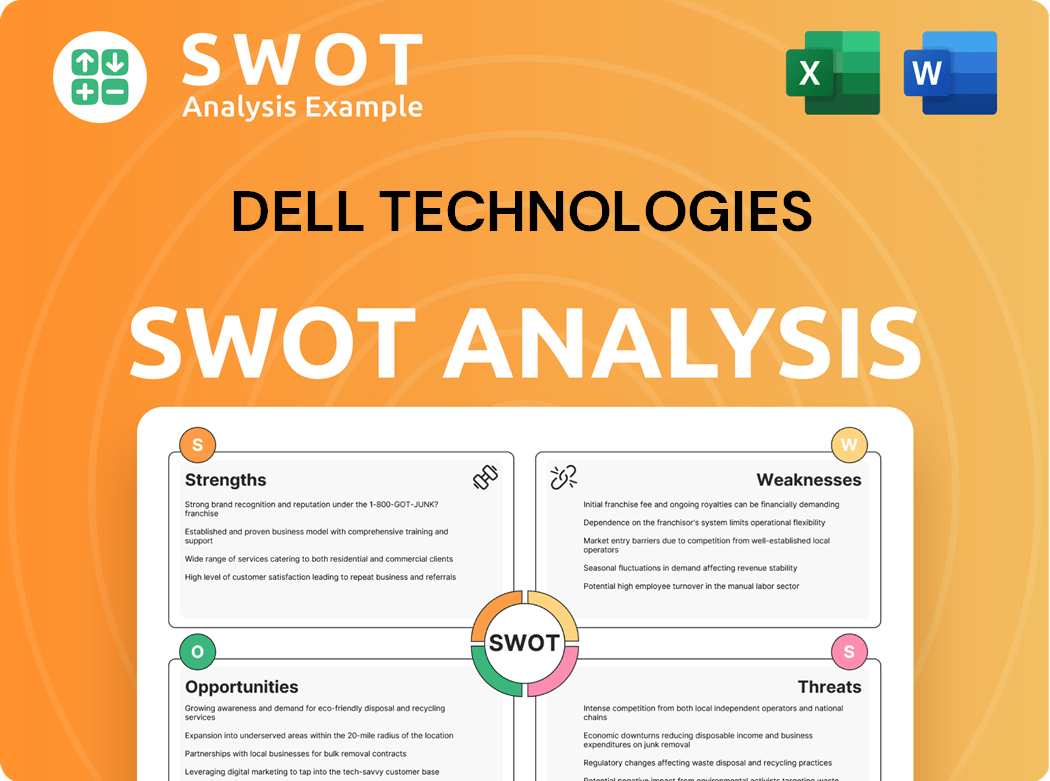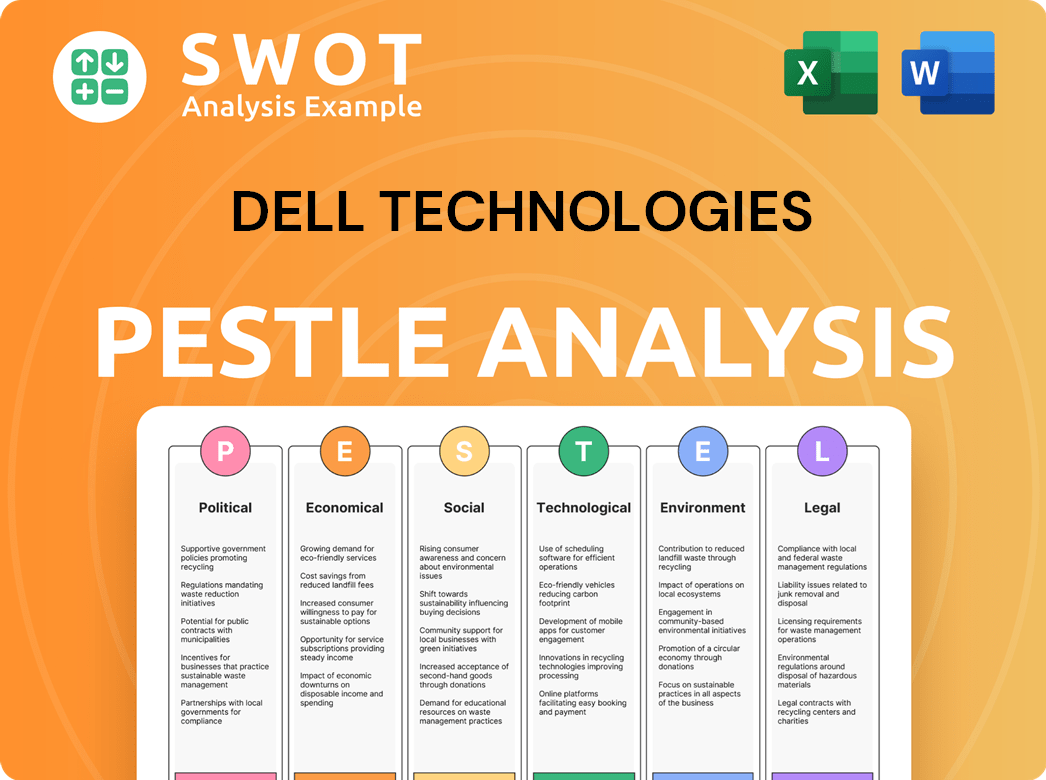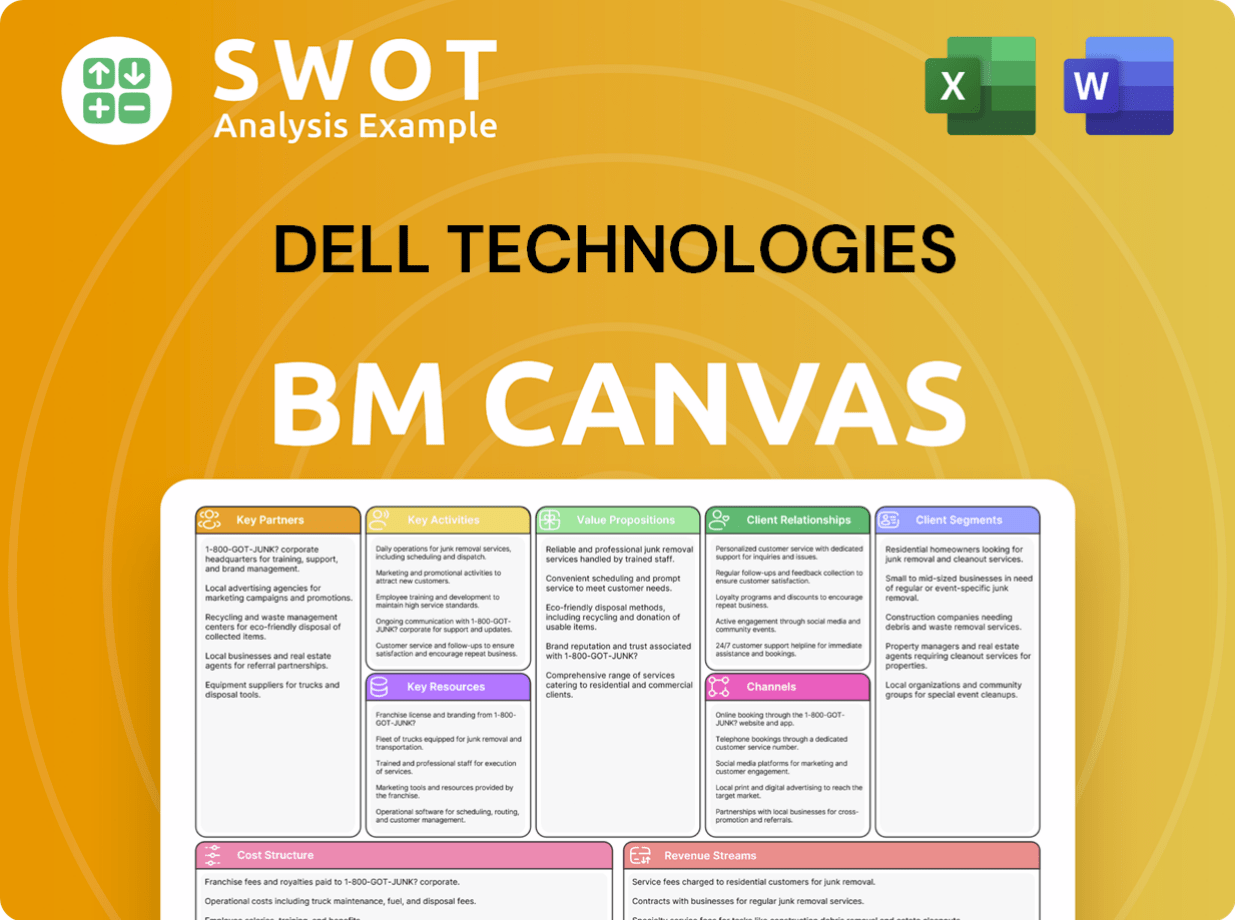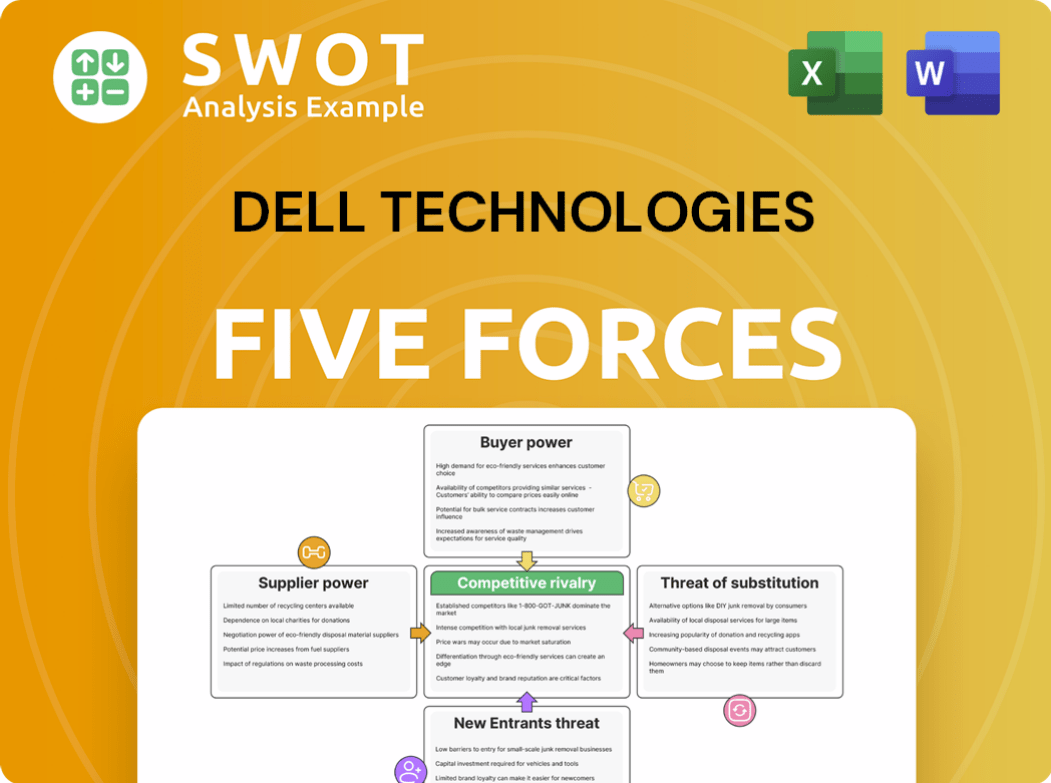Dell Technologies Bundle
How Did a Dorm Room Startup Become a Tech Giant: The Dell Technologies Story?
From a humble beginning in 1984, Dell Technologies, under the visionary leadership of Michael Dell, disrupted the tech industry. Starting with just $1,000, Dell pioneered a direct-to-consumer model, offering customized PCs and quickly gaining traction. This approach differentiated the Dell Technologies SWOT Analysis from its competitors, setting the stage for remarkable growth.

This brief history of Dell computers showcases the company's transformation from a PC manufacturer to a global technology leader. Dell's evolution over time, including key milestones and strategic acquisitions, reflects its adaptability and commitment to innovation. Explore the early days of Dell, its impact on the tech industry, and its expansion into enterprise solutions to understand the company's enduring success and its role in the personal computer market.
What is the Dell Technologies Founding Story?
The story of Dell Technologies began on May 3, 1984. It was founded by Michael Dell, then a freshman at the University of Texas at Austin. Initially, the company operated under the name PC's Limited.
Michael Dell's background, combined with a mere $1,000 in capital, drove his entrepreneurial spirit. He saw an opportunity in the personal computer market. The goal was to avoid traditional retail channels. This would eliminate unnecessary costs and create a direct connection between the manufacturer and the consumer.
The primary issue Dell aimed to address was the absence of direct customization and efficient delivery of personal computers. The original business model focused on selling IBM-compatible PCs. These were built from stock components and sold directly to consumers. This approach allowed for tailored configurations, a revolutionary concept at the time.
Dell history is marked by innovation and strategic decisions. The company's direct sales model set it apart in the PC market.
- The Turbo PC, introduced in 1985, was priced at $795.
- Michael Dell dropped out of university to focus on the business.
- The company generated $73 million in revenue by the end of its first year.
- Initial funding was primarily through bootstrapping, starting with $1,000.
The first product, the Turbo PC, was introduced in 1985. It was competitively priced at $795 and advertised with the motto 'Purely You.' A pivotal moment in the Dell company story was Michael Dell's decision to leave university after his first year. He dedicated himself to the burgeoning business. By the end of its first full year, the company had already achieved an impressive $73 million in revenue. The early success of PC's Limited was largely due to its lean approach. This involved direct engagement with customers, setting it apart in a rapidly growing market. The strategy was a key factor in the company's early success.
Michael Dell's vision transformed the personal computer market. His innovative approach to sales and customer service was a significant factor in the company's early growth. The company's direct sales model, combined with its focus on customer needs, allowed it to quickly gain market share. The company's early success laid the foundation for its future growth and expansion. Learn more about the company's core values and mission by reading Mission, Vision & Core Values of Dell Technologies.
Dell Technologies SWOT Analysis
- Complete SWOT Breakdown
- Fully Customizable
- Editable in Excel & Word
- Professional Formatting
- Investor-Ready Format

What Drove the Early Growth of Dell Technologies?
The early growth of the company, initially known as PC's Limited, was marked by rapid expansion within the personal computer market. The company's direct-to-consumer model, which allowed for customized PC assembly, was a key factor in its success. The company's evolution is a significant part of the brief history of Dell computers. This period saw the company transform from a startup to a global PC manufacturer.
After launching its first in-house designed computer, the Turbo PC, in 1985, the company achieved $73 million in revenue by the end of its first full year. This early success set the stage for future growth. The company, under the leadership of Michael Dell, quickly gained traction. This was a pivotal moment in the early days of Dell.
In 1987, the company rebranded as Dell Computer Corporation and launched its first international subsidiary in the United Kingdom. This marked the beginning of its geographical expansion. This strategic move helped the company reach new markets. The company's evolution over time included significant international growth.
Dell's growth trajectory continued with its initial public offering (IPO) in 1988, raising $30 million and bringing the company's market capitalization to $85 million. This influx of capital fueled further global expansion, with manufacturing centers opening in Europe, the Middle East, and Africa. By the mid-1990s, Dell had expanded across Asia and Japan. The company's financial performance history shows the impact of this period.
In 1992, Dell Computer Corporation was recognized by Fortune Magazine, being listed among the Fortune 500 largest companies in the world. Throughout this period, Dell maintained its focus on direct sales, which remained a core strategic strength. The company's ability to adapt to market changes and offer competitive pricing were key factors in its growth. For more insights, explore the Competitors Landscape of Dell Technologies.
Dell Technologies PESTLE Analysis
- Covers All 6 PESTLE Categories
- No Research Needed – Save Hours of Work
- Built by Experts, Trusted by Consultants
- Instant Download, Ready to Use
- 100% Editable, Fully Customizable

What are the key Milestones in Dell Technologies history?
The Dell Technologies company, a major player in the tech industry, has achieved several significant milestones throughout its history. From its early days as a PC manufacturer to its expansion into enterprise solutions, the company has consistently adapted to market changes. These achievements showcase Dell's evolution over time and its impact on the tech industry.
| Year | Milestone |
|---|---|
| 1984 | Michael Dell founded the company, initially as PC's Limited, with a focus on direct sales. |
| 1988 | Dell Inc. went public, marking a significant step in its growth. |
| 2001 | Dell became the world's number one PC vendor, highlighting its success in the personal computer market. |
| 2013 | Michael Dell took the company private to refocus on innovation and adapt to market changes. |
| 2016 | Dell merged with EMC Corporation, the largest tech acquisition at the time, expanding its enterprise solutions. |
Dell's success has been driven by its innovative approaches to product development and customer service. A key innovation was the direct-to-consumer sales model, which allowed for mass customization of PCs and provided superior customer service. This approach set Dell apart from other PC manufacturers and helped it gain a competitive edge.
Dell pioneered a direct-to-consumer sales model, eliminating intermediaries and allowing for customized PC configurations. This approach enabled Dell to offer competitive pricing and build strong customer relationships.
Dell allowed customers to customize their PCs, offering a wide range of options for hardware and software. This customization was a key differentiator, providing customers with products tailored to their specific needs.
Dell implemented efficient supply chain management practices, reducing costs and improving delivery times. This efficiency helped Dell maintain a competitive advantage in the market.
Dell expanded into enterprise solutions, including data storage, cloud computing, and security. This strategic shift reduced dependence on the declining PC market and diversified revenue streams.
Dell has invested heavily in research and development, particularly in Artificial Intelligence (AI) and machine learning technologies. This focus aims to drive innovation and create new opportunities.
Dell has developed flexible consumption models, including as-a-service offerings, to meet evolving customer needs. These models provide customers with greater flexibility and cost-effectiveness.
Despite its successes, Dell has faced several challenges, including market downturns and intense competition. The declining PC market, particularly around 2012, and competitive pressures from companies like HP, Lenovo, and Apple, have necessitated strategic adjustments. Dell's ability to adapt to these challenges has been crucial for its long-term survival.
Dell has faced market downturns, particularly in the PC market, which have impacted its revenue and profitability. These downturns required strategic pivots to maintain growth.
Intense competition from companies like HP, Lenovo, and Apple has put pressure on Dell's pricing and market share. Dell has responded by focusing on innovation and customer service.
The decline in the PC market, especially around 2012, forced Dell to diversify its product offerings and focus on enterprise solutions. This shift was crucial for its survival.
Geopolitical risks and tariffs have presented challenges, potentially increasing costs and disrupting supply chains. Dell has worked to mitigate these risks through strategic planning.
Attempts to enter the smartphone and tablet markets were largely unsuccessful, as Dell was primarily viewed as a PC company. These ventures highlighted the challenges of market diversification.
Dell has faced competitive pricing pressures, particularly within its Client Solutions Group (CSG). This has required Dell to focus on cost efficiency and value-added services.
Dell Technologies Business Model Canvas
- Complete 9-Block Business Model Canvas
- Effortlessly Communicate Your Business Strategy
- Investor-Ready BMC Format
- 100% Editable and Customizable
- Clear and Structured Layout

What is the Timeline of Key Events for Dell Technologies?
The story of Dell Technologies, a significant player in the tech industry, began in 1984. Founded by Michael Dell, the company has evolved significantly over the years, from its humble beginnings as PC's Limited to a global technology leader. This journey includes pivotal moments like going public, expanding internationally, and making strategic acquisitions. Through innovation and adaptation, Dell's evolution over time reflects its commitment to providing cutting-edge solutions and services.
| Year | Key Event |
|---|---|
| 1984 | Michael Dell founded PC's Limited with $1,000 from his University of Texas dorm. |
| 1985 | The company designed and introduced its first computer, the Turbo PC. |
| 1987 | PC's Limited was rebranded as Dell Computer Corporation and opened its first international subsidiary in the UK. |
| 1988 | Dell went public, raising $30 million. |
| 1992 | Dell Computer Corporation entered the Fortune 500 list. |
| 1995 | Dell expanded worldwide operations across Europe, Asia, Japan, and the Americas. |
| 1998 | Dell achieved $12 million in daily sales via the internet. |
| 2001 | Dell became the world's number one PC vendor. |
| 2013 | Michael Dell took the company private in a leveraged buyout. |
| 2016 | Dell merged with EMC to form Dell Technologies, the largest tech merger at the time. |
| 2021 | Dell Technologies spun off VMware and released Dell Apex, its 'as-a-service' portfolio. |
| 2023 | Dell announced one of the world's broadest generative AI infrastructure portfolios. |
| 2025 | Dell Technologies reported full-year fiscal 2025 revenue of $95.6 billion, up 8% year over year, with AI server orders exceeding $12 billion in Q1 fiscal 2025. |
Dell Technologies is heavily investing in AI and data solutions to lead the digital revolution. This includes significant research and development efforts focused on scalable technologies, particularly in AI and machine learning. The company is also exploring new areas like edge computing and telecommunications.
Dell anticipates full-year fiscal 2026 revenue between $101.0 billion and $105.0 billion. This projection reflects an expected 8% year-over-year growth at the midpoint. The company expects AI server shipments to exceed $15 billion in fiscal year 2026.
Dell is actively forming strategic partnerships, such as with NVIDIA and Google, to drive AI innovation and provide future-ready solutions. The 'AI Factory' approach aims to accelerate AI innovation by combining AI-optimized infrastructure, validated solutions, and expert services.
While facing challenges in the consumer PC market and competitive pricing, Dell's strategic shift towards high-margin AI infrastructure is expected to drive future success. Michael Dell believes AI technologies will be the dominant theme through the end of the decade. Read more about Dell's impact on the tech industry.
Dell Technologies Porter's Five Forces Analysis
- Covers All 5 Competitive Forces in Detail
- Structured for Consultants, Students, and Founders
- 100% Editable in Microsoft Word & Excel
- Instant Digital Download – Use Immediately
- Compatible with Mac & PC – Fully Unlocked

Related Blogs
- What is Competitive Landscape of Dell Technologies Company?
- What is Growth Strategy and Future Prospects of Dell Technologies Company?
- How Does Dell Technologies Company Work?
- What is Sales and Marketing Strategy of Dell Technologies Company?
- What is Brief History of Dell Technologies Company?
- Who Owns Dell Technologies Company?
- What is Customer Demographics and Target Market of Dell Technologies Company?
Disclaimer
All information, articles, and product details provided on this website are for general informational and educational purposes only. We do not claim any ownership over, nor do we intend to infringe upon, any trademarks, copyrights, logos, brand names, or other intellectual property mentioned or depicted on this site. Such intellectual property remains the property of its respective owners, and any references here are made solely for identification or informational purposes, without implying any affiliation, endorsement, or partnership.
We make no representations or warranties, express or implied, regarding the accuracy, completeness, or suitability of any content or products presented. Nothing on this website should be construed as legal, tax, investment, financial, medical, or other professional advice. In addition, no part of this site—including articles or product references—constitutes a solicitation, recommendation, endorsement, advertisement, or offer to buy or sell any securities, franchises, or other financial instruments, particularly in jurisdictions where such activity would be unlawful.
All content is of a general nature and may not address the specific circumstances of any individual or entity. It is not a substitute for professional advice or services. Any actions you take based on the information provided here are strictly at your own risk. You accept full responsibility for any decisions or outcomes arising from your use of this website and agree to release us from any liability in connection with your use of, or reliance upon, the content or products found herein.